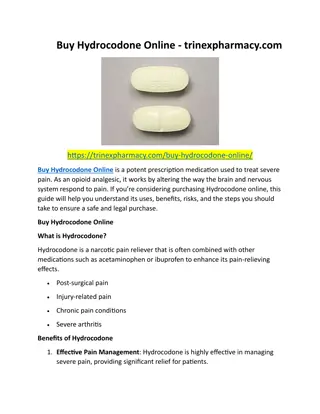BUY ACTAVIS OXYCODONE 30MG CAPSULE ONLINE - OPIOIDS.TO
Actavis oxycodone 30mg capsules are These capsules contain oxycodone, which is a potent opioid analgesic. Actavis oxycodone 30mg capsule Let\u2019s explore some key information about Actavis oxycodone 30mg capsules Email: OpioidMedShop@gmail.com Contact: 1 902 400 3630
1 views • 3 slides
Pharmaceutical Chemistry Analgesic Agents Narcotic Analgesics
Analgesic agents play a crucial role in managing pain, ranging from mild to severe, with different categories such as opioids, NSAIDs, and triptans. The origin of pain can vary from physiological to neuropathic causes. Opioids target opioid receptors, with discoveries in endogenous ligands like enke
4 views • 49 slides
Emergency Dentist Donvale
When a tooth-ache develops, there are very few things that will settle it. Over the counter analgesic medications can dull the pain for a short period of time but it won\u2019t alleviate the pain completely nor will it solve the underlying problems. When a tooth pulp\/ nerve becomes inflamed due to
2 views • 7 slides
Understanding Nonsteroidal Anti-Inflammatory Drugs (NSAIDs) and Their Pharmacology
Nonsteroidal anti-inflammatory drugs (NSAIDs) are a class of analgesic, antipyretic, and anti-inflammatory medications that work by inhibiting prostaglandin synthesis. They provide relief from pain, reduce fever, and combat inflammation through various mechanisms. Aspirin, a commonly used NSAID, irr
0 views • 21 slides
Preparation of Aspirin: Overview and Synthesis Methods
The preparation of aspirin involves the synthesis of 2-acetyl salicylic acid, known for its therapeutic uses as an analgesic, antipyretic, and anti-inflammatory agent. This process includes the detailed characteristics, stability, mechanism, and synthesis methods of aspirin. Important considerations
0 views • 12 slides
Understanding Non-Steroidal Anti-Inflammatory Drugs (NSAIDs): Types and Classification
Non-Steroidal Anti-Inflammatory Drugs (NSAIDs) are a diverse group of medications with analgesic, anti-inflammatory, and antipyretic properties. They act primarily on peripheral pain mechanisms and vary in their selectivity of COX inhibition. This article explores the history, classification, and se
3 views • 16 slides
Acetaminophen Synthesis Process Explained
Acetaminophen, also known as paracetamol, is a widely used analgesic and fever-reducing medicine. The synthesis of acetaminophen involves treating an amine with an acid anhydride to form an amide. This process includes mixing reactants, isolating crude acetaminophen, and purifying the final product.
0 views • 17 slides
Understanding Paracetamol: Usage, Metabolism, and Side Effects
Paracetamol, a widely used non-opioid analgesic, is effective for treating musculoskeletal pains and headaches. This synthetic medication primarily acts in the Central Nervous System and is available in various forms. However, caution is advised due to potential side effects such as rare skin reacti
0 views • 31 slides
Complexity in Cancer Pain Management by Dr. Marie Joseph
Dr. Marie Joseph explores the challenges and successes of managing complex pain in cancer patients. The intricacies of neuropathic pain, diagnostic characteristics, pathophysiology, pharmacology, and typical cancer pain syndromes are discussed. Strategies such as co-analgesic adjuvants, analgesic sy
0 views • 12 slides
Buy Hydrocodone Online - trinexpharmacy
Buy Hydrocodone Online is a potent prescription medication used to treat severe pain. As an opioid analgesic, it works by altering the way the brain and nervous system respond to pain. \nContact : 1 (747) 209 \u2013 3649\nE-mail : sales@trinexpharma
0 views • 13 slides
Understanding Methyl Salicylate: Preparation and Uses
Methyl Salicylate, commonly known as oil of wintergreen, is produced through Fischer Esterification by heating salicylic acid with methyl alcohol. It has various applications, from being a rubefacient and analgesic in liniments to a flavoring agent in gums and mints. It is also used in microscopy, f
0 views • 14 slides
Patterns of Pregabalin Use among People Who Inject Drugs in Australia
This study explores the patterns and correlates of pregabalin use among individuals who frequently inject drugs in Australia. Pregabalin, a GABA analogue with analgesic and anti-convulsant effects, has been increasingly used and misused in the country. The research aims to identify prescribed and no
0 views • 16 slides
Synthesis of Salicylic Acid: Theory, Derivatives, and Applications
Salicylic acid is synthesized from methyl salicylate through ester hydrolysis with aqueous alkali. It is a versatile compound used in organic synthesis, as a plant hormone, and derived from salicin metabolism. The derivatives of salicylic acid can minimize gastric disturbances and enhance therapeuti
4 views • 12 slides
Overview of Salicylic Acid and its Derivatives
Salicylic acid is known for its antiseptic, germicidal, and analgesic properties, used in various applications such as preservatives, wart treatments, and pain relief. Different derivatives of salicylic acid are developed to minimize side effects and enhance efficacy. Acetyl salicylic acid (ASA), co
0 views • 15 slides
Why and How to Buy Tramadol Online
Tramadol is a prescription medication primarily used to treat moderate to moderately severe pain. It is classified as an opioid analgesic and works by altering the way the brain and nervous system respond to pain. Due to its effectiveness, many indiv
0 views • 5 slides
Understanding Pain: Mechanisms and Pathways
This content delves into the intricate mechanisms of pain perception, exploring the anterolateral system, nociceptors, endogenous analgesic systems, and more. It covers topics such as free nerve endings, VR1/Capsaicin receptors, referred pain, neuropathic pain, hyperalgesia, and visceral pain. The m
0 views • 15 slides
Overview of Non-Steroidal Anti-Inflammatory Drugs (NSAIDs) in Veterinary Pharmacology
Non-steroidal anti-inflammatory drugs (NSAIDs) are a diverse group of medications with analgesic, anti-inflammatory, and antipyretic effects. They act primarily on peripheral pain mechanisms and have limited CNS effects. NSAIDs have a long history dating back to the use of White Willow bark, and the
0 views • 16 slides
Understanding Non-Opioid Pain Management Strategies
Non-opioid pain management is crucial in the current opioid epidemic, requiring physicians to navigate chronic pain without relying on opioids. This comprehensive approach involves a deep understanding of non-opioid analgesic medications, the nature of pain, anatomy, and physiology of nociception, t
0 views • 36 slides
Overview of Narcotic Analgesics and Opioids
Narcotic analgesics, such as opiates and opioids derived from opium, interact with specific opioid receptors in the body to produce analgesic effects. Different opioid receptors have varying effects, with mu (MOP) being a good analgesic but with adverse effects, delta (DOP) and kappa (KOP) have nuan
0 views • 6 slides
Synthesis and Purification of Acetaminophen (Paracetamol) for Analgesic Properties
Acetaminophen, a widely used analgesic and anti-pyretic agent, is synthesized and purified in this experiment. The process involves suspending P-aminophenol in water, reacting with acetic anhydride, filtering, crystallizing, and collecting the product. The compound's mechanism of action, chemical pr
0 views • 15 slides
Comprehensive Guide to Ketamine Use in Palliative Medicine: Indications, Effects, and Dosage
Ketamine, a Schedule 2 controlled substance, is utilized as a third-line analgesic for managing complex pain conditions. Acting as an N-methyl-D-aspartate (NMDA) receptor inhibitor, it exerts analgesic effects by antagonizing the NMDA receptor, impacting neuronal hyperexcitability and reducing opioi
0 views • 17 slides
Analgesic Study with Three Treatments Crossed with Gender
This study explores the effects of analgesic treatments crossed with gender on pain levels. The data analysis includes factors such as gender and drug type, and the statistical model examines pain index as a linear function of factor levels. The ANOVA results indicate significant effects of gender,
0 views • 17 slides





















